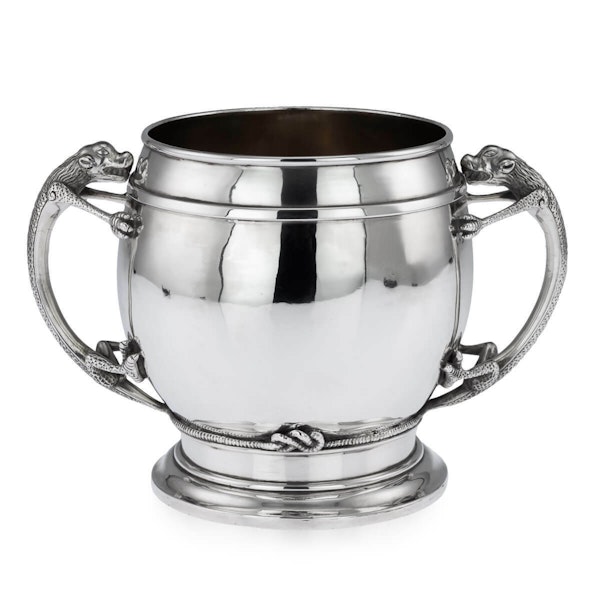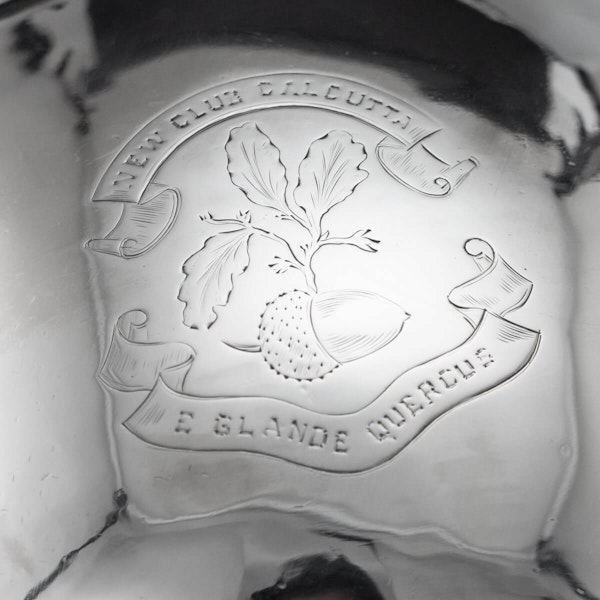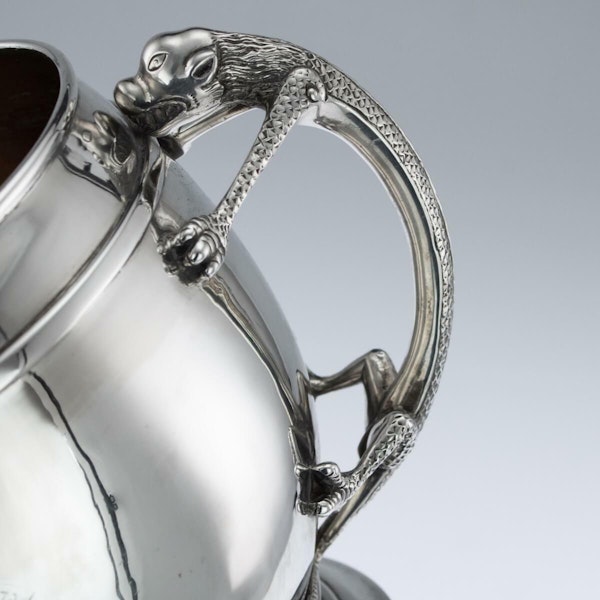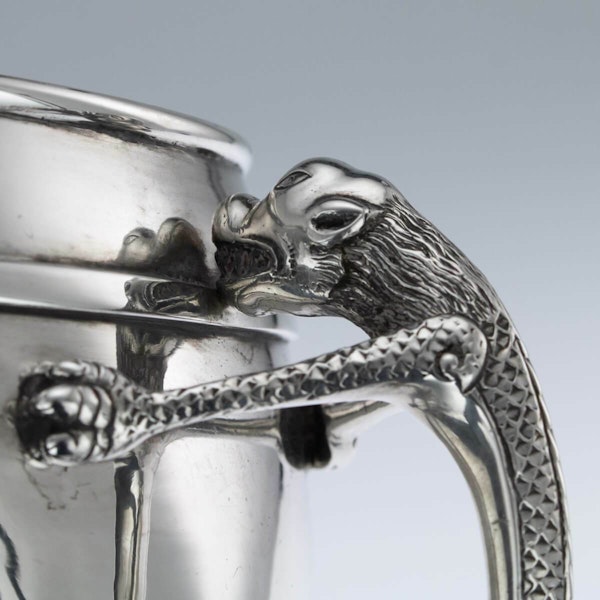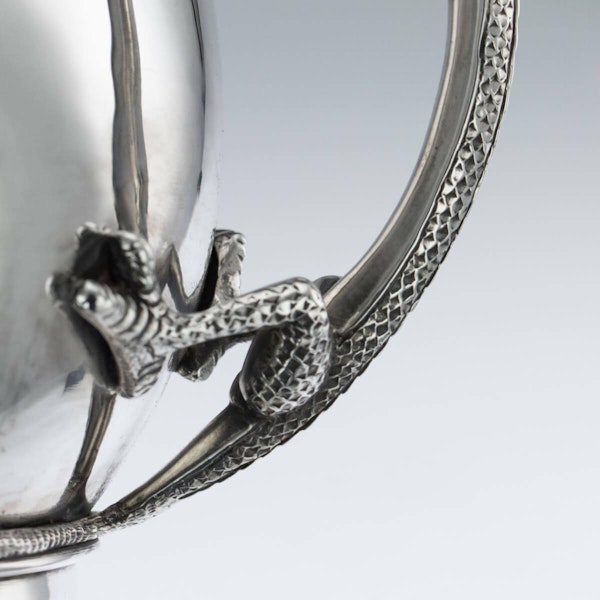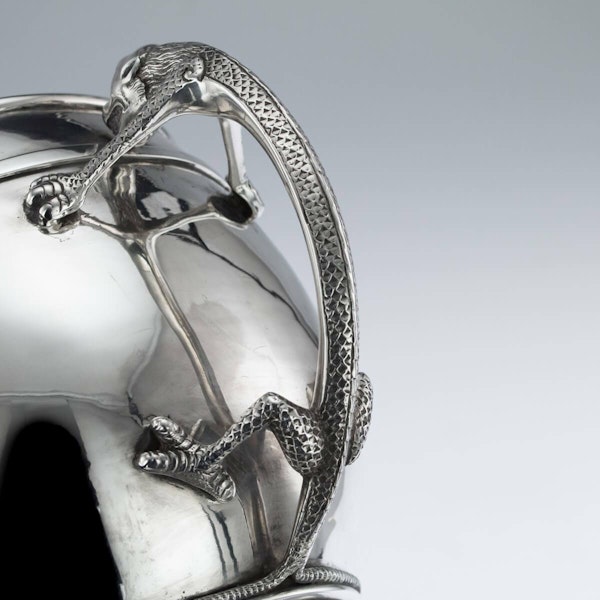Antique Indian Silver Presentation Cup, New Club, Calcutta, India - C. 1900
Antique Indian Silver Presentation Cup, New Club, Calcutta, India - C. 1900
£1,350.00
Description
This lovely antique Indian Silver Presentation Cup has two handles and sits on a pedestal foot. It was probably given as a prize. The silver is of good gauge and weight and for this reason Calcutta silverware has sometimes been described as ‘bombproof’, meaning that items like this could withstand daily use easily. The cup dates to around 1900, and although unsigned, was probably made in one of the many high-quality silver workshops operating in Calcutta at that time.
The handles are in the form of Hindu mythological composite creatures, known as yali. They are described as having a lion’s head, elephant tusks, the body of a cat and a serpent’s tail. Their appearance is quite comical, they have large, wide open eyes and large teeth. Their expression is one of alarm; their lips are drawn back in a rictus as they appear to be having difficulties clinging on to the side of the cup. Their arms and legs are splayed out, wide apart and their tails wrap around the top of the pedestal, knotting at the centre front and centre back. Their bodies have been chased with details. To centre front, the cup bears the emblem and motto of the New Club, Calcutta, which was founded in 1884. The motto of The New Club, “E Glande Quercus”, translates as ‘from the acorn the oak’.
Clubs in British India were originally intended to provide reasonably priced accommodation for members as Europeans did not tend to have private residential and dining quarters until the 1850s and 60s. The members also provided company, information, help and support to new arrivals from Europe or other parts of India, which made it much easier for those new arrivals to quickly find their feet and feel like an established member of the ex-patriot community.
Established in 1827, The Bengal Club was the most exclusive in Calcutta with its membership restricted to the top officials and senior partners of the most established managing agency houses. Until the 1940s, these Clubs were not open to Indians. The Calcutta Club, founded in 1907, was the exception. The Viceroy of India, Lord Minto, had wished to invite the pioneering Bengali industrialist, Rajen Mookerjee, to dine at the Bengal Club and uproar had ensued. The Club set up an outdoor dining space to circumnavigate the problem and the meeting went ahead outdoors in the Club grounds. This incident resulted in the opening of the Calcutta Club in 1907 which was set up to operate with a membership policy not dictated by race and succeeded in attracting members from various racial backgrounds including British and Indian.
Admittance to membership of clubs like the Bengal Club, was by a ballot of members, which, in the 19th century at least, ensured a strict ‘whites only’ and strictly male membership. It also ensured that only the top echelons of British society could gain admittance there, which institutionalised the social divisions inherent in European society.
By the 1880s, as the European population grew in India and particularly in Calcutta, so did the need for more clubs to accommodate the Europeans, particularly the less elevated members of society. One of these was The New Club, which was established in 1884, with premises in Park Street, Calcutta, to cater for a range of social backgrounds and interests. It specialised in amateur dramatics and later offered professional theatricals. It also offered facilities for lawn tennis and billiards as well as holding house dinners, concerts and dances.
| item details | |
|---|---|
| Origin | Asian |
| Period | Early 1900s |
| Style | Other |
| Condition | Excellent |
| Dimensions | Height 15 cms; Width (max) 21 cms |
| Diameter | Weight: 892 grammes |
Product REF: 10042


